
Think of your favourite song. It probably took just three minutes to enjoy, but behind it lies an intricate web of studios, rights, streaming deals, royalties, and boardroom battles. If you look from a businessman’s lens, the Indian music industry isn’t just about melodies and moods. In this edition, we break down the whole value chain of the Indian music ecosystem: who creates the music, who owns it, who distributes it, and, most importantly, who profits from it. You’ll understand why players operating in a particular part of the value chain wield disproportionate power, why streaming platforms in India struggle to churn out profits, and how music stacks up against films and OTT in terms of monetisation potential. If you’ve ever wondered where the money really goes when you press play, this one’s for you.
Indians love to listen to music, be it a trendy Bollywood song, an old classic, a Punjabi hit, or an indie Gujarati sensation (and yes, Marathi music too), We listen to it all. Following are FICCI’s 2024 estimates:
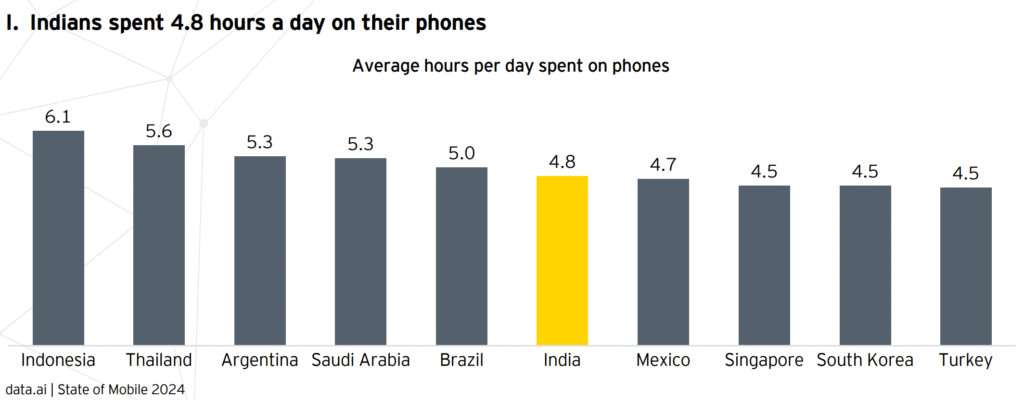
(Source: FICCI & EY M&E Research Report)
Out of the total time spent on phones, India spends 78% of its time on media and entertainment apps. Out of this 78%, 50% of the time is devoted to Social Media, which is driven by short video content created around news, music, entertainment and gaming. Be it on Spotify, Instagram Reels, or even in TV commercials, music is in everything, everywhere, all at once.
The music industry is one of the fastest-growing sub-segments in India’s media and entertainment (M&E) sector. With cheap mobile data, a young population hooked on streaming, and the viral magic of short-form videos, music consumption has exploded-making it one of the most valuable forms of content. The following is a snapshot of the contribution of various sub-sectors of the M&E sector.
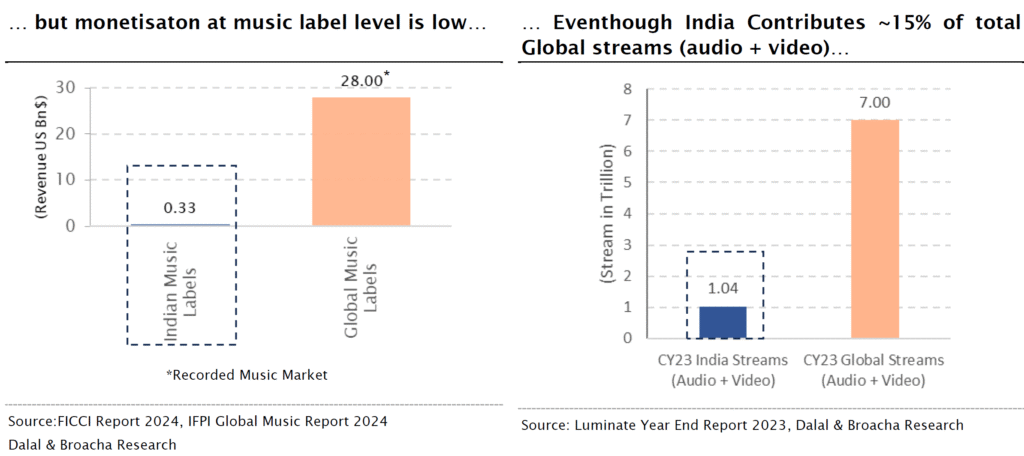
(Source: FICCI & EY M&E Research Report)
Although music currently accounts for a modest ~2% of the total M&E industry, it is expected to grow at a ~14% CAGR between FY24 and FY27, second only to live events (~18%).
Potential Remains Underappreciated
If you look deeper into this, music isn’t just its own category. It seeps into digital, film, advertising, and live events, amplifying its reach far beyond what it gets credit for. Yet, despite such high engagement with billions of streams and massive daily consumption, the revenue per listener (monetization) remains shockingly low. That mismatch between how much we consume music and how little it earns per user? That’s the most fascinating part of the business.
India’s music market still lags globally in monetization. Indians spend over 24 hours a week listening to music, above the global average of ~21 hours, and contribute around 15% of global audio and video streams. Yet, monetization remains a challenge. The share of paid subscribers is low, leading to an average revenue per user (ARPU) of just $3, well below the ~$8 average seen in other emerging markets.
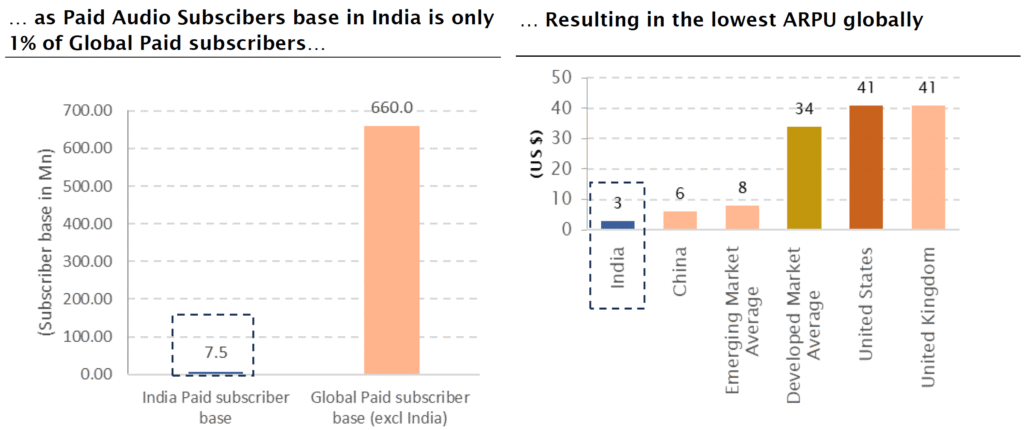
(Source: Dalal & Broacha Research)
This mix of under-penetration, low ARPU, and high engagement perfectly sets the stage for what could be one of India’s biggest digital media opportunities.
Music – The Most Monetizable Sub-Segment
Before we dive into the numbers, it’s worth stepping back and asking why are we making such a statement? what makes music such a powerful business? Why does it often outshine films or TV shows in the long run? What makes it one of the most valuable and enduring forms of content?
In summary, it boils down to FIVE things: a) shelf life, b) repeatability, c) relevance, d) monetization potential, and e) reach. For instance, news gets old in hours, TV shows fade after a season, even films, unless they’re blockbusters, have a short window. But music? it sticks. Here’s how music stacks up against other entertainment forms on the five key dimensions:
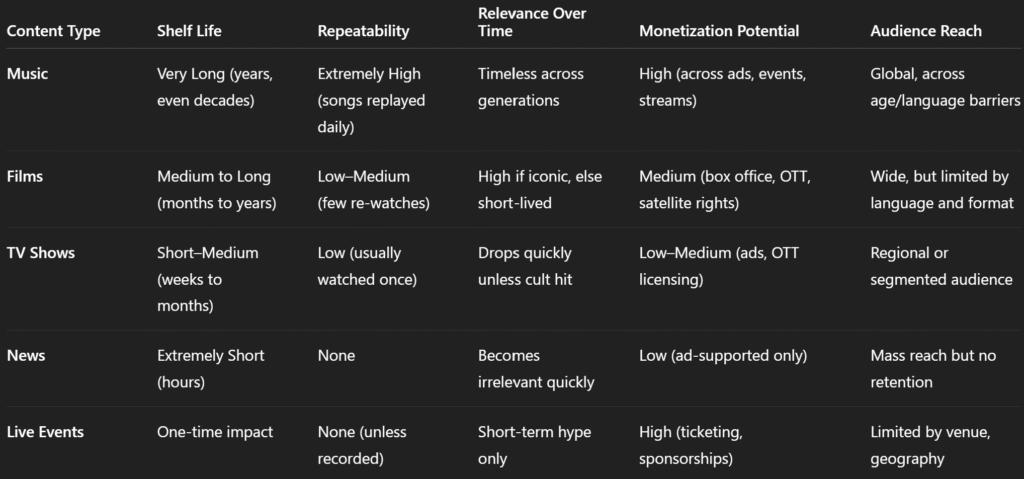
You stream the same song 50 times, across platforms, moods, and moments, that’s what makes music not just an art but also a money-making machine. Listeners return to the same songs again and again, a favourite track might be replayed hundreds of times, becoming part of someone’s memories and moods. That repeat consumption gives music immense economic potential, especially in the digital age where distribution is almost costless.
What truly sets music apart is its role in daily life. It doesn’t demand full attention like a movie or show, it plays while we cook, commute, or even sleep. It’s flexible, emotional, and deeply personal. That one song from your school days? It still stirs something. From a business perspective, that emotional bond is what makes music one of the most enduring and valuable content types in the long run.
Understanding the Value Chain
Let’s now peel back the curtain on how the music business actually works. It all starts with the creators, the artists and composers. But once a track is born, it’s the music labels that step in and take charge. They bankroll the production, push the song into the spotlight, distribute it across platforms, and crucially, they usually own the rights. And those rights? That’s where the gold is.
Every time the song is streamed, played at a wedding, synced in a film, or used in an ad, it’s the label that collects the royalty. The real business of music lies in this chain, and understanding who controls what is key to knowing who makes the most money.

(Source: IP, TIPS Music)
India’s Copyright Law – A Blessing in Disguise
What makes music such a powerful asset is that you don’t just earn from it once, you earn for decades. Thanks to India’s copyright law, the rights to a song are protected for 60 years (from the beginning of the next calendar year) after its release, allowing content owners to monetize it over and over again. Whether it’s used in a remix, a film, an Instagram reel, or a brand campaign, the owner earns every time. That’s why music isn’t just content, it’s long-term IP.
Take the song “Chaiyya Chaiyya” from Dil Se (1998). Over 25 years later, it’s still used in ads, stage performances, and social media. Every use means a royalty and that’s the kind of longevity most content can’t match.
Who Captures the Value (and Who Doesn’t)
If you think artists make the most money in the music business, hate to break it to you but that’s not how it works. In reality, artists often earn the least from streaming. The real money flows to the music labels, because they own the most valuable piece of the puzzle: the rights. Whether a song is blowing up on YouTube, playing at a concert, or synced to a film, it’s the label that takes a cut, every single time.
What makes this model so powerful is the library they build. Every new hit adds to a growing catalogue, an income-generating asset that pays for decades. The bigger the library, the more revenue streams they unlock. It’s a virtuous cycle: own more music, earn more, sign more artists, repeat. Labels don’t just make money off trends, they own the rights to them. Following is a clear comparison table showing how music labels capture more value and operate on a stronger business model than other participants in the music value chain:
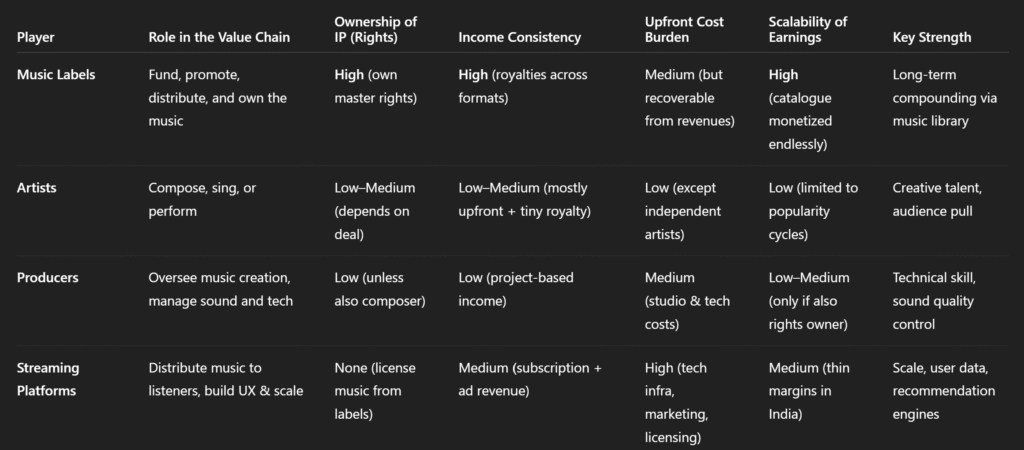
Bollywood is no longer the only game in town. Independent artists, regional language creators, and YouTube-born musicians are capturing massive audiences. Tamil, Telugu, Punjabi, and Bhojpuri songs are going viral, often even internationally. Short-form video has turbocharged this trend. One viral reel can shoot a song into the limelight, with platforms like Reels and Shorts influencing charts more than traditional radio. Hit-making has fundamentally changed. Here is how the YouTube views for Saregama and Tips Music for YouTube stackup over the past few years:

(Source: Company, Bastion Research)
Streaming Platforms and Their Struggles (in India)
If you are feeling sad about the artists, let me tell you that streaming platforms in India aren’t exactly swimming in profits either. Their biggest hurdle is that most users simply don’t want to pay. Add to that cut-throat competition and high content costs, especially the hefty licensing fees paid to music labels. This makes it easy to see why streaming platforms operate on razor-thin margins. Low ARPU, high payouts, and a market hooked on free content make survival a challenge.
Once a frontrunner in India’s music streaming race, Gaana.com had everything in its favour: a massive user base, early-mover advantage, and backing from Times Internet. But by 2022, it scrapped its free tier and went subscription-only, struggling to survive in a market where most users simply refuse to pay. The platform was eventually acquired in a distress sale by ENIL in 2023, underscoring just how tough the economics had become.
Gaana isn’t alone. Hungama Music, despite over a decade in the game, officially shut down in April 2025. Wynk pivoted out in 2024, and even Resso, backed by ByteDance, pulled the plug after rights holders exited over poor monetization. All of them hit the same wall: low ARPU, high licensing costs, and a user base hooked on free content. It’s a déjà vu that keeps playing out. In India, user love is abundant, but unless that love converts to rupees, there’s no business to stream.
Here are some statements made by the management of the couple of above mentioned platforms:
Resso: A ByteDance spokesperson said regarding Resso’s India exit: “Unfortunately, owing to local market conditions, we can no longer continue to serve users of Resso in India.” They acknowledged its failure to convert free listeners to subscriptions and noted Sony Music had withdrawn its catalogue over poor conversion rates.
Wynk Music: Airtel’s leadership pointed out: “People in India don’t like paying for music… while Wynk had a lot of customers, they don’t pay… its subscription model had not done well.” Consequently, Airtel decided to retire Wynk in favor of a partnership with Apple Music, citing unsustainable economics and inability to scale profitably.
Immense Potential and the Silver Lining
India has so much potential and so much underpenetration, that in almost every industry, even a slight shift in consumer behaviour can unlock outsized growth. Music is no different. For years, the country has been hooked on free streaming, making it a market with massive engagement but minimal monetization. But that’s starting to change. Paid music subscriptions have grown from around 8 million in 2022 to ~10-11 million in 2024, and industry leaders believe we’re just scratching the surface with this number expected to reach to 20-21 million by 2027.
As Jay Mehta, MD of Warner Music India, put it: “If even a fraction of India’s 550 million YouTube users converted to paid streaming, the country could quickly rival global music markets.” With pricing innovation (like ₹1/day plans), bundled offers, and rising digital comfort, the old “why pay for music?” mindset is finally cracking. And in a country this big, even a small crack can turn into a goldmine.
Conclusion
India is the textbook case of a high-volume, low-monetization market. Millions stream daily, but only a small fraction pays. Even a modest jump in paid users or better monetization per stream could unlock outsized growth, and global players are watching.
Music labels are best positioned to lead. They hold the rights and access to multiple revenue streams: royalties, sync deals, licensing, performance rights, and global distribution. They’re doubling down too, Saregama plans to invest ₹1,000 crore over FY25–27, while Tips Music will spend 25-28% of topline (₹80-100 crore) in FY26 alone. Clearly, the battle for catalogue dominance is heating up.
All this makes one thing clear: the Indian music industry is tuning up for its next act. What was once an underrated sliver of media is now stepping into the spotlight. Whether you’re a casual listener, a creator chasing your next big break, or just someone curious about content businesses, this is an industry worth keeping your ears on.
Because the next big business story might not come from your screen. It might already be playing in your headphones.
If you enjoyed reading this newsletter, please feel free to share it with others who might find it insightful. We’d also love to hear your thoughts and feedback on X. Connect with us there at @bastionresearch.
Happy Investing!!!
😂Meme of the Week🤣





